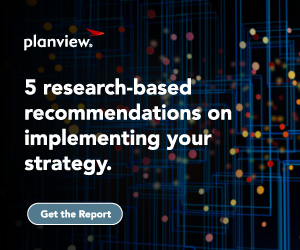
What’s old is new again.
As organizations rush to capitalize on AI strategies, many of them meet the same challenge they’ve met before – strategic drift.
Wayfaring strategies aren’t uncommon. In fact, studies show that strategy implementation failure rates can reach as high as 60% to 90%. The consequences reach everyone in the company’s orbit, from employees and executives to stakeholders and customers.
Strategic drift could cost organizations up to $1.4 trillion dollars a year by 2026.
The latest research by Economist Impact, commissioned by Planview, explores the topic of why strategies fail. Pulling from the survey responses of 600 executives, the report uncovers five areas of concern — alignment, accountability, resources, agility, and culture — and a recommended action for each area.
Read the full report: Att överbrygga klyftan: att omvandla strategi till verklighet
Organizational change is the hidden common denominator in applying the recommendations in the report. However, survey results indicate that many organizations lack the necessary mindset, structures, and culture to affect “the people side” of change.
- A startling 85% of executives say their organization’s ability to adapt to change falls short.
- Over 80% of executives acknowledged the need to enhance their companies’ internal communication, cross-functional collaboration, and employee engagement.
- More than four out of five executives recognize the need to improve employee engagement.
Effective change management is required for sustained success in delivering strategic initiatives. Moreover, Organizational Change Management (OCM) principles are pivotal in steering the ship toward successful strategy design and implementation.
A Blueprint for Navigating Change
In this blog post, you’ll uncover a three-part blueprint for navigating organizational change, enabling you to address some of the key interpersonal components of failed strategies. You will:
- Journey into the intricate world of OCM, gaining an overview of its crucial role.
- Investigate key strategies designed to align stakeholders seamlessly, emphasizing their profound impact in managing organizational change.
- Explore the interconnected building blocks that bridge the often-challenging gap between strategy and implementation.
Låt oss börja.
Aligning key stakeholders in organizational change
The first cornerstone in the blueprint focuses on aligning key stakeholders during the crucial phases of strategy design and implementation. By exploring stakeholder alignment, we divide the nuanced elements that propel successful change initiatives.
From early engagement in strategic planning and grounding strategies on business realities to encouraging buy-in through transparent communication and creating purposeful connections between daily tasks and overarching strategies, we illuminate the path toward building a cohesive and supportive foundation for change.
Prioritizing strategic initiatives for effective change management
Moving forward, we navigate the landscape of effective change management by spotlighting the significance of prioritizing strategic initiatives.
By improving the understanding of why resource allocation for strategic initiatives is critical, organizations gain a strategic advantage in optimizing efforts, ensuring judicious use of resources, and maximizing impact.
Within this realm of change, we identify that the strategic process of prioritization and uncovering its role in identifying trade-offs is about helping leaders understand the resources essential for success.
Building a culture that supports organizational change
At the heart of successful organizational change management lies a culture that actively supports transformation.
Our exploration extends to evaluating the profound impact of culture on strategic objectives, emphasizing the alignment of organizational values with strategic goals. We also investigate the assessment of governance structures, recognizing their role in either facilitating or hindering change initiatives.
Dessutom betonar vi ledningens centrala ansvar för att forma och stärka en kultur som är i linje med de strategiska målen och som aktivt driver på och upprätthåller dem. Nyckeln till att förändra en kultur ligger i ledarens tankesätt som samlar de rätta principerna för förändring.
Interdependence Matters
The journey takes a holistic turn as we explore the interconnectedness of the five key recommendations in the report by Economist Impact, emphasizing their collective role in bridging the strategy-implementation gap.
This underscores the power derived from the seamless integration of strategies, creating a comprehensive blueprint for effective change management. The call to action resonates with the need for a holistic and integrated approach, encouraging organizations to adopt dynamic strategies in an age defined by agility and organizational change management.
Expand Your Toolkit for Taming Strategic Drift
The blueprint unveiled in this blog post serves as a guiding light for organizations seeking resilience and adaptability. By embodying these principles, organizations can confidently navigate organizational change, ensuring they thrive in an ever-evolving business environment.
In a time of exponential change, strategies must be as dynamic as the landscapes they navigate. The ability to pivot, replan, or reprioritize when the market changes enables topline growth, as well as faster time-to-market. Leaders must be able to:
- Understand the simultaneous forces of change that cause instability
- Keep current on the role of technology (including AI-powered products and services)
- Advance change in the organization with intentional action
Learn the prominent sources of change in the Digital Age, plus the required technology capabilities and research-backed leadership recommendations for navigating change in Shift vs Drift: Connecting Strategy to Outcomes in Rapid Change.




